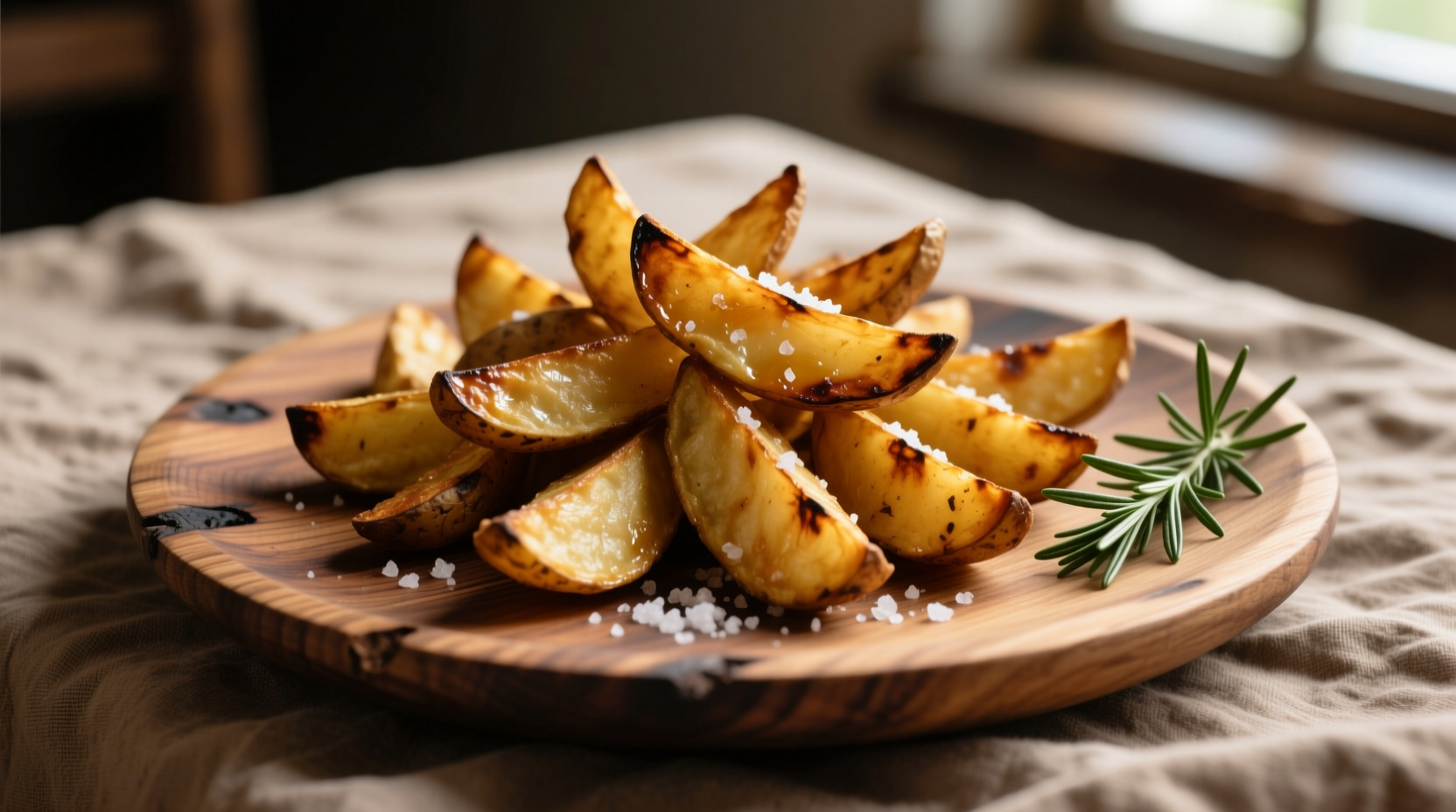The Essential Guide to Perfect Potato Wedges
Nothing beats the satisfying crunch of a perfectly cooked potato wedge—golden brown edges giving way to a tender, fluffy center. Unlike traditional fries, wedges maintain more of the potato's natural nutrients and offer a heartier texture that holds up to bold seasonings. Whether you're cooking for a family dinner or preparing game day snacks, mastering this simple side dish elevates any meal with minimal effort.

Why Potato Wedges Outperform Traditional Fries
The growing popularity of potato wedges over conventional fries stems from their superior texture profile and nutritional advantages. While both start with the same humble ingredient, the wedge's thicker cut creates a more substantial eating experience with better structural integrity.
| Characteristic | Potato Wedges | Traditional Fries |
|---|---|---|
| Cooking Time | 25-35 minutes | 3-5 minutes (deep fry) |
| Surface Area to Volume Ratio | Lower (more interior) | Higher (more exterior) |
| Nutrient Retention | Higher (skin retained) | Lower (peeled) |
| Oil Absorption | 20-25% less | Standard absorption |
Choosing the Ideal Potato Variety
Not all potatoes create equally impressive wedges. The starch content dramatically affects texture outcomes. Russet potatoes (also called Idaho) remain the professional chef's top choice for their high starch content and thick skin that crisps beautifully. Yukon Gold varieties offer a middle ground with buttery flavor and moderate starch, while waxy potatoes like red bliss generally produce disappointing results due to their high moisture content.
According to USDA agricultural research, Russets contain approximately 21-22% starch compared to Yukon Gold's 16-17% and red potatoes' 14-15%. This higher starch content creates the fluffy interior that defines exceptional wedges. When selecting potatoes, choose specimens that feel heavy for their size with smooth, unblemished skins.
The Science of Perfect Crispiness
Achieving that coveted crispy exterior requires understanding basic food chemistry. The Maillard reaction—the chemical process between amino acids and reducing sugars that creates browning—occurs most effectively between 285-325°F (140-163°C). However, potatoes must first reach 212°F (100°C) to evaporate surface moisture before browning can begin.
Professional kitchens leverage a two-stage cooking process: first baking at 375°F (190°C) to cook through without burning, then increasing to 425°F (220°C) for the final 5-7 minutes to maximize crispiness. This method, documented in culinary research from the Culinary Institute of America, produces wedges with optimal texture contrast.
Step-by-Step Preparation Method
Cutting Technique Matters
Start by washing potatoes thoroughly—never peel them, as the skin contains valuable nutrients and provides structural integrity. Cut each potato lengthwise into 6-8 equal wedges, ensuring uniform thickness for even cooking. Professional chefs recommend using a serrated knife for cleaner cuts through the skin.
The Critical Soaking Process
Soaking wedges in cold water for 30-60 minutes removes excess surface starch that would otherwise create soggy results. For enhanced crispiness, some chefs add 1 tablespoon of vinegar per quart of water, which helps break down pectin in the potato cells. Drain and thoroughly dry wedges with paper towels before seasoning—wet potatoes steam rather than crisp.
Seasoning and Cooking
Toss wedges with 1-2 tablespoons of high smoke-point oil (avocado or grapeseed work best) and your preferred seasonings. Spread in a single layer on a parchment-lined baking sheet with space between pieces. Bake at 375°F for 25 minutes, flip, then increase temperature to 425°F for 5-7 minutes until golden brown.
Troubleshooting Common Problems
Soggy wedges? This typically indicates insufficient drying after soaking or overcrowded baking sheets. Ensure wedges have space for air circulation and rotate the pan halfway through cooking.
Burnt edges but raw centers? Your oven temperature may be inaccurate. Use an oven thermometer to verify actual temperature, as many home ovens run hotter than indicated.
Lack of crispiness? Try finishing under the broiler for 1-2 minutes, watching carefully to prevent burning. The intense direct heat creates instant crispiness without overcooking.
Nutritional Benefits Compared to Fries
According to USDA FoodData Central, a 100g serving of baked potato wedges contains approximately 95 calories, 2.1g fiber, and significant potassium and vitamin C—naturally higher than fried alternatives due to retained skin and less oil absorption. When prepared with minimal oil, wedges provide a nutrient-dense side dish that complements balanced meals.
Perfect Pairings and Serving Suggestions
Potato wedges shine alongside grilled proteins, particularly burgers, chicken, and fish. Their substantial texture makes them ideal for scooping up flavorful dips like garlic aioli, chipotle ranch, or classic ketchup. For brunch service, top wedges with a fried egg and chopped herbs. The versatility of potato wedges extends to international flavor profiles—toss with smoked paprika for Spanish-inspired wedges, or cumin and coriander for Middle Eastern variations.
Frequently Asked Questions
What's the best way to reheat leftover potato wedges?
Reheat potato wedges in a 400°F oven for 8-10 minutes or in an air fryer at 380°F for 3-4 minutes. Avoid microwaving, which creates sogginess. The dry heat of oven or air fryer restores crispiness without drying out the interior.
Can I make potato wedges without oil?
Yes, though results will be less crispy. For oil-free wedges, toss thoroughly dried wedges with 1 tablespoon cornstarch and seasonings before baking. The cornstarch creates a light coating that promotes browning. Expect slightly drier texture but still flavorful results.
Why do my potato wedges stick to the baking sheet?
Sticking occurs when wedges aren't sufficiently oiled or when removed too soon. Always line baking sheets with parchment paper, ensure wedges have adequate oil coating, and allow them to develop a crust before flipping (about 15-20 minutes into baking).
How far in advance can I cut potatoes for wedges?
Cut potatoes no more than 2 hours before cooking for best results. Longer storage causes oxidation and texture degradation. If preparing ahead, store cut wedges submerged in cold water with lemon juice to prevent browning, but dry thoroughly before seasoning and baking.











 浙公网安备
33010002000092号
浙公网安备
33010002000092号 浙B2-20120091-4
浙B2-20120091-4